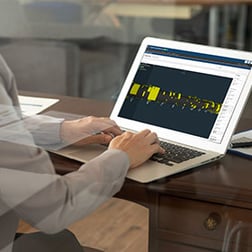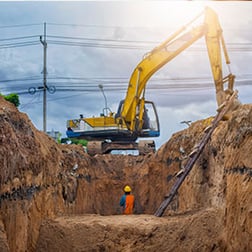One Bridge Solutions
How to Enhance Pipeline Data Visibility and Accessibility Across Teams
There’s no doubt that the past year has been challenging, with serious workplace upheaval thanks to COVID-19. As a result, integrity management now takes a hybrid workplace approach that includes both remote and in-office options. Employees require exceptional pipeline data accessibility and visibility to collaborate effectively across teams.
Integrated software like OneBridge’s Cognitive Integrity Management (CIM) supports remote working, collaboration and superior decision-making by uniting pipeline engineering information within an enterprise.
Here’s how cross-functional teams can harness this solution to improve their integrity data management.
Create a complete view of integrity by integrating datasets
Pipeline companies accumulate vast quantities of detailed data, and integrity engineers typically spend much of their time cobbling together information from numerous, disjointed sources.
Without a coherent “full picture,” vital decisions are made based on partial information.
How can integrity management teams get a complete view of the whole? By integrating multiple datasets.
As data capture technology constantly grows, the ability to see how datasets relate to each other is indispensable for integrity work. An integrity software system that can overlay multiple data sets in a single view gives engineers access to deeper insights and advanced analysis. Imagine having cathodic protection data linked to ILI run info; or superimposing information from a chemical injection program onto a corrosion growth map.
OneBridge’s CIM platform is a centralized data integrator that combines all integrity-related datasets into a single platform. It allows teams to step back and see the big picture. And because CIM runs on Microsoft Azure, important data is protected by world-class security and is accessible to employees, no matter their location.
Reduce errors by aligning pipeline data
Operators manage decades of integrity information, and there are bound to be discrepancies and data alignment errors. Issues with missing and misaligned info often occur between dissimilar data types.
- First-generation data. Paper alignment sheets, which likely contain only basic information at various levels of scale, detail and accuracy.
- Second-generation data. Transitioning paper alignment sheets to represent the actual geographic state of the pipeline.
- Third-generation data. Complex modern IMU-driven datasets, which often create a new geographic location to the actual datapoint/dataset that has been offset.
For a threat management team, alignment is crucial for accurate analysis and is one of the main focuses of integrity work. By automating alignment, time can be spent on detailed analysis, identifying patterns and future planning.
CIM is an integrated platform powered by machine learning and data science that can align all three generations of data and:
- Bring together years of ILI integrity information. No matter the format or vendor, once CIM ingests data, it’s automatically standardized and aligned.
- Correlate out-of-sync asset data. CIM’s algorithms can automatically align asset management system data to third-generation geographic data. This includes repair, GIS, HCA, coating type, asset data and more. CIM accomplishes this while maintaining the integrity of the data in those systems.
- Connect the dots for every assessment. By automatically bringing together the ILI integrity information over a pipeline’s lifetime and correlating out-of-sync data, operators are provided with a better representation of the pipe and its long-term depth and growth trends.
A platform that completes this heavy lifting and automatically flags alignment issues ultimately helps an integrity team decrease errors and improve decision-making confidence in their data.
Boost collaboration by improving accessibility for remote environments
The demand for remote pipeline data accessibility skyrocketed during the pandemic as employees began working from home. From now on, remote-working integrity teams will want sophisticated—more effective—access to threat-assessment info and tools as global work environments change to a “new” normal.
The lack of visibility across teams is one of the major challenges of remote work environments. When people can’t converse freely, plans stagnate. Similarly, when updates cannot be accessed or aligned, employees hit a wall resulting from the poor data.
Using a single platform for integrity management, one that’s accessible anywhere, anytime, and communicates with your asset management systems, alleviates team indecision and miscommunication.
Within CIM are monitoring and reporting features that support collaboration.
- Leaders can track users within the system, follow project progress and zero in on who’s working on what.
- Users can leverage comment and push notification functionality to aid cross-functional teams, even when colleagues are on different shifts or time zones.
OneBridge wants to help operators maintain pipeline integrity with greater confidence. Part of that mission includes ensuring our software supports collaboration to better enable remote oil and gas work.
Keep teams from falling behind by adding real-time updates
Modern integrity management systems employ machine learning and data science to continually gather, process, align and analyze incoming information. This is a departure from older data management systems where outdated data resulted in employees waiting for updates or creating an ad hoc workaround.
The ability to process new data, non-stop, via cloud computing is the future of integrity management—and a key feature of CIM.
Cognitive Integrity Management, CIM, learns to ingest and align datasets quickly. For instance:
- ILI runs
- Cathodic protection surveys
- GIS information
- NDE results
- Repair data
When ingesting data, the software automatically performs over 2,000 checks. It runs self-learning classifiers, which automatically compare GIS and integrity data in the alignment process, highlighting errors and inconsistencies in the source data. Once updated, users can immediately access the most current reports and unity plots.
It’s an increasing challenge for teams to keep their finger on the pulse of integrity management. Machine learning offers a simple way forward. Its algorithms align all available data sources in a cloud environment, where different teams can work together to validate data efficiently. Ultimately, everyone gains more confidence in their integrity-related decisions.
Contact OneBridge to find out how CIM leverages your internal systems to support teams in making better integrity decisions.


















